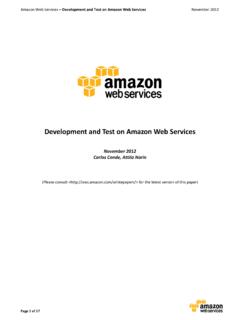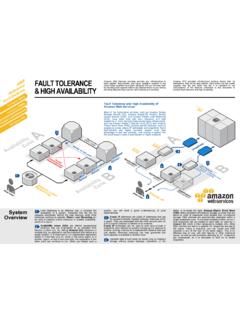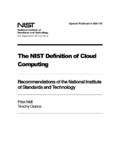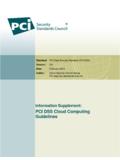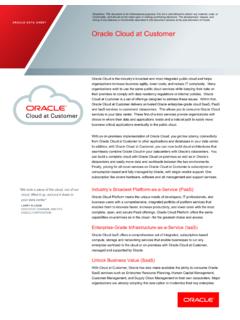Transcription of Architecting for the Cloud: Best Practices
1 Amazon Web Services - Architecting for The cloud : best Practices January 2011. Architecting for the cloud : best Practices January 2011. Jinesh Varia Page 1 of 23. Amazon Web Services - Architecting for The cloud : best Practices January 2011. Introduction For several years, software architects have discovered and implemented several concepts and best Practices to build highly scalable applications. In today's "era of tera", these concepts are even more applicable because of ever-growing datasets, unpredictable traffic patterns, and the demand for faster response times. This paper will reinforce and reiterate some of these traditional concepts and discuss how they may evolve in the context of cloud computing. It will also discuss some unprecedented concepts such as elasticity that have emerged due to the dynamic nature of the cloud . This paper is targeted towards cloud architects who are gearing up to move an enterprise-class application from a fixed physical environment to a virtualized cloud environment.
2 The focus of this paper is to highlight concepts, principles and best Practices in creating new cloud applications or migrating existing applications to the cloud . Background As a cloud architect, it is important to understand the benefits of cloud computing. In this section, you will learn some of the business and technical benefits of cloud computing and different AWS services available today. Business Benefits of cloud Computing There are some clear business benefits to building applications in the cloud . A few of these are listed here: Almost zero upfront infrastructure investment: If you have to build a large-scale system it may cost a fortune to invest in real estate, physical security, hardware (racks, servers, routers, backup power supplies), hardware management (power management, cooling), and operations personnel. Because of the high upfront costs, the project would typically require several rounds of management approvals before the project could even get started.
3 Now, with utility-style cloud computing, there is no fixed cost or startup cost. Just-in-time Infrastructure: In the past, if your application became popular and your systems or your infrastructure did not scale you became a victim of your own success. Conversely, if you invested heavily and did not get popular, you became a victim of your failure. By deploying applications in-the- cloud with just-in-time self-provisioning, you do not have to worry about pre-procuring capacity for large-scale systems. This increases agility, lowers risk and lowers operational cost because you scale only as you grow and only pay for what you use. More efficient resource utilization: System administrators usually worry about procuring hardware (when they run out of capacity) and higher infrastructure utilization (when they have excess and idle capacity). With the cloud , they can manage resources more effectively and efficiently by having the applications request and relinquish resources on- demand.
4 Usage-based costing: With utility-style pricing, you are billed only for the infrastructure that has been used. You are not paying for allocated but unused infrastructure. This adds a new dimension to cost savings. You can see immediate cost savings (sometimes as early as your next month's bill) when you deploy an optimization patch to update your cloud application. For example, if a caching layer can reduce your data requests by 70%, the savings begin to accrue immediately and you see the reward right in the next bill. Moreover, if you are building platforms on the top of the cloud , you can pass on the same flexible, variable usage-based cost structure to your own customers. Reduced time to market: Parallelization is the one of the great ways to speed up processing. If one compute-intensive or data-intensive job that can be run in parallel takes 500 hours to process on one machine, with cloud architectures [6], it would be possible to spawn and launch 500 instances and process the same job in 1 hour.
5 Having available an elastic infrastructure provides the application with the ability to exploit parallelization in a cost-effective manner reducing time to market. Page 2 of 23. Amazon Web Services - Architecting for The cloud : best Practices January 2011. Technical Benefits of cloud Computing Some of the technical benefits of cloud computing includes: Automation Scriptable infrastructure : You can create repeatable build and deployment systems by leveraging programmable (API-driven) infrastructure. Auto-scaling: You can scale your applications up and down to match your unexpected demand without any human intervention. Auto-scaling encourages automation and drives more efficiency. Proactive Scaling: Scale your application up and down to meet your anticipated demand with proper planning understanding of your traffic patterns so that you keep your costs low while scaling. More Efficient Development lifecycle: Production systems may be easily cloned for use as development and test environments.
6 Staging environments may be easily promoted to production. Improved Testability: Never run out of hardware for testing. Inject and automate testing at every stage during the development process. You can spawn up an instant test lab with pre-configured environments only for the duration of testing phase. Disaster Recovery and Business Continuity: The cloud provides a lower cost option for maintaining a fleet of DR servers and data storage. With the cloud , you can take advantage of geo-distribution and replicate the environment in other location within minutes. Overflow the traffic to the cloud : With a few clicks and effective load balancing tactics, you can create a complete overflow-proof application by routing excess traffic to the cloud . Understanding the Amazon Web Services cloud The Amazon Web Services (AWS) cloud provides a highly reliable and scalable infrastructure for deploying web-scale solutions, with minimal support and administration costs, and more flexibility than you've come to expect from your own infrastructure, either on-premise or at a datacenter facility.
7 AWS offers variety of infrastructure services today. The diagram below will introduce you the AWS terminology and help you understand how your application can interact with different Amazon Web Services and how different services interact with each other. Amazon Elastic Compute cloud (Amazon EC2)1 is a web service that provides resizable compute capacity in the cloud . You can bundle the operating system, application software and associated configuration settings into an Amazon Machine Image (AMI). You can then use these AMIs to provision multiple virtualized instances as well as decommission them using simple web service calls to scale capacity up and down quickly, as your capacity requirement changes. You can purchase On-Demand Instances in which you pay for the instances by the hour or Reserved Instances in which you pay a low, one-time payment and receive a lower usage rate to run the instance than with an On-Demand Instance or Spot Instances where you can bid for unused capacity and further reduce your cost.
8 Instances can be launched in one or more geographical regions. Each region has multiple Availability Zones. Availability Zones are distinct locations that are engineered to be insulated from failures in other Availability Zones and provide inexpensive, low latency network connectivity to other Availability Zones in the same Region. 1. More info about Amazon EC2 is available at Page 3 of 23. Amazon Web Services - Architecting for The cloud : best Practices January 2011. Figure 1: Amazon Web Services Elastic IP addresses allow you to allocate a static IP address and programmatically assign it to an instance. You can enable monitoring on an Amazon EC2 instance using Amazon CloudWatch2 in order to gain visibility into resource utilization, operational performance, and overall demand patterns (including metrics such as CPU utilization, disk reads and writes, and network traffic). You can create Auto-scaling Group using the Auto-scaling feature3 to automatically scale your capacity on certain conditions based on metric that Amazon CloudWatch collects.
9 You can also distribute incoming traffic by creating an elastic load balancer using the Elastic Load Balancing4 service. Amazon Elastic Block Storage (EBS)5 volumes provide network-attached persistent storage to Amazon EC2 instances. Point-in-time consistent snapshots of EBS volumes can be created and stored on Amazon Simple Storage Service (Amazon S3)6. Amazon S3 is highly durable and distributed data store. With a simple web services interface, you can store and retrieve large amounts of data as objects in buckets (containers) at any time, from anywhere on the web using standard HTTP. verbs. Copies of objects can be distributed and cached at 14 edge locations around the world by creating a distribution using Amazon CloudFront7 service a web service for content delivery (static or streaming content). Amazon SimpleDB8. is a web service that provides the core functionality of a database- real-time lookup and simple querying of structured data - without the operational complexity.
10 You can organize the dataset into domains and can run queries across all of the data stored in a particular domain. Domains are collections of items that are described by attribute-value pairs. 2. More info about Amazon CloudWatch is available at 3. More info about Auto-scaling feature is available at 4. More info about Elastic Load Balancing feature is available at 5. More info about Elastic Block Store is available at 6. More info about Amazon S3 is available at 7. More info about Amazon CloudFront is available at 8. More info about Amazon SimpleDB is available at Page 4 of 23. Amazon Web Services - Architecting for The cloud : best Practices January 2011. Amazon Relational Database Service9 (Amazon RDS) provides an easy way to setup, operate and scale a relational database in the cloud . You can launch a DB Instance and get access to a full-featured MySQL database and not worry about common database administration tasks like backups, patch management etc.



